Last week, I went to Starbucks for a cup of coffee and overheard this conversation between two young entrepreneurs who were trying to find new ways to get more business. Apparently, their eCommerce business has been going well, so they were discussing new marketing ways to let more people know about their products. If I were looking to partner with a startup, I would definitely consider talking with them.
The ideas for online promotion they were discussing were really interesting and forward-looking. Except one.
“Everybody is an influencer now and people are tired of that. Besides, the two don’t really go that well together. I think we should go with our current strategy and look for opportunities elsewhere.”
This was the reaction of one of them to an idea to explore influencer marketing. Apparently, their brand was doing quite a bit of affiliate marketing, but for some reason, they decided that influencer marketing won’t do any good to them.
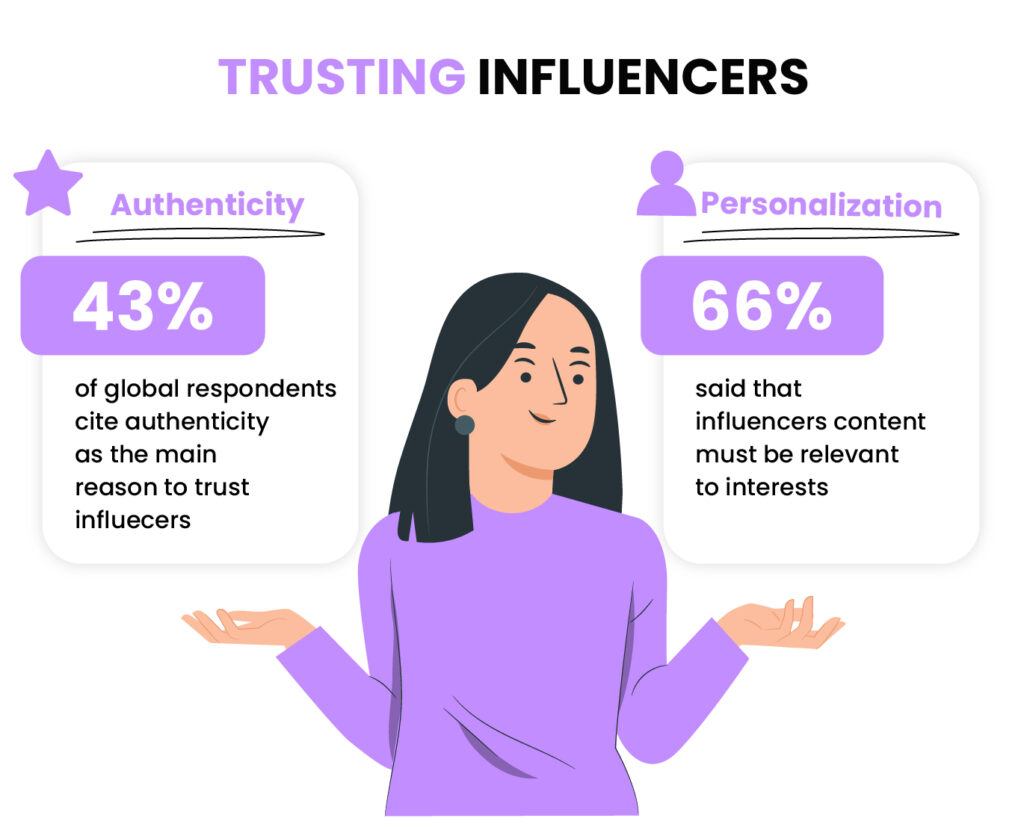
Don’t get me wrong, this is not the first time I hear something like this. Many entrepreneurs perceive influencer marketing as a bad addition to their strategy because of the overwhelming number of people who consider themselves influencers.
Well, blogging was also once considered as nothing but a hobby. But now, blogging is a legit marketing technique that, if implemented properly, can get your business on the first page of Google results as well as help to build a sizable lead base.
If not, why would 86 percent of B2C businesses use content marketing – blogging included – as a part of their digital marketing strategy?
The fact that a lot of people are trying to be influencers doesn’t mean that using influencer marketing is a bad idea. In fact, influencer marketing has been developing at the speed of light in recent years, with an increasing number of businesses investing thousands in this strategy. For example, Instagram influencer marketing spending worldwide is quickly increasing; it reached $5.67 billion in 2018 and is projected to hit the mark of $8.08 billion by the end of 2020.
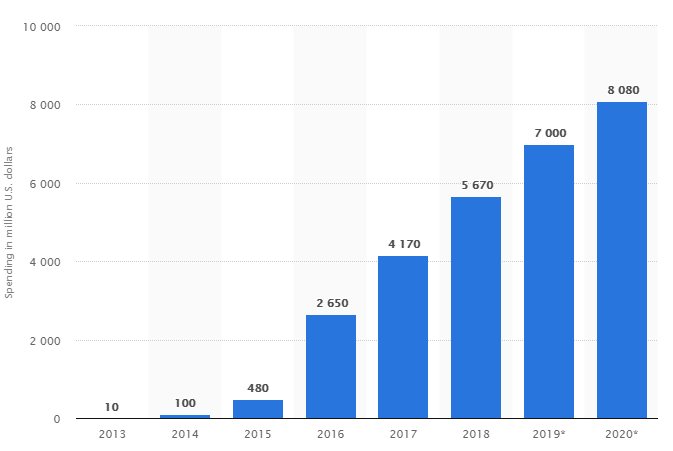
Image Credit: Statista
So, why would businesses around the world continue to pour money into influencer marketing if doing so would be like throwing money out the window?
Exactly.
And is the combination of affiliate marketing and influencer marketing worth pursuing?
Absolutely!
If you know how to do it properly, of course.
Why Influencer Marketing is perfect for Affiliate Marketing
Historically, affiliate marketing has been driven by the need to get website clicks, but now things are changing a little bit. The traditional affiliate marketing techniques are being added more with the new ones, and these are focused on cultivating leads from social media platforms.
That’s where influencers do their magic.
They have that amazing ability to inspire conversions from their followers, which is something that affiliate marketing could really use. So, it could be said that influencer marketing enhances traditional affiliate marketing techniques by introducing them to content-driven audiences who use social media on a daily basis.
Influencers will surely be responsible for a large part of the U.S. affiliate marketing spending, which by the way, is projected to reach $6.8 billion by the end of 2020, according to eMarketer.
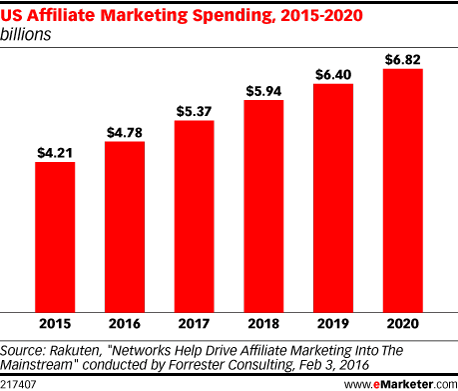
Credit: eMarketer
So, it makes perfect sense for social media-savvy affiliates to try and create meaningful influencer campaigns that leverage the reviewing and buying power of influencers. By doing things this way, a business goes beyond website clicks and focuses on the main thing that drives purchases in younger generations: long-term relationships with brands that turn customers into loyal followers.
An influencer thus becomes a critical intermediary in fostering these meaningful relationships between a business and a customer by sharing tips, recommendations, and other information that the customer can use. For example, here’s how Cristine Rotenberg, an Instagram & YouTube influencer with a username Simply Nailogical, promotes clothing brand called Roots in this post on Instagram.

Credit: Instagram
So, thinking that influencer marketing and affiliate marketing cannot be combined is simply unreasonable.
But how can a business actually do it? Read below to find out.
How to Combine Affiliate Marketing and Influencer Marketing
First, let’s make sure that you understand what you’re getting yourself into. The best way to think about an influencer is a unique type of partner for affiliate marketing. Why unique? Because he or she has several qualities that are critical to success, including marketing experience, direct access to your target audience, authority in your market niche, and a certain degree of expertise in technology and social media areas.
But the most important quality that influencers have is trust. Every effective influencer has a certain number of followers who are interested in their lifestyle tips, product recommendations, and other information. The trust of followers allows influencers to use traditional affiliate methods very effectively because the people reading or otherwise consuming their content are interested in recommendations from them.
So, working with a decent influencer whose market niche happens to relate to your products or services provides you with direct access to your target audience. By partnering with an influencer, in this case, you’re increasing the chance of conversion because the audience is relevant and interesting in learning more about products or services you sell.
So, this means that you’ll have to do influencer research to find a relevant one for your business. He or she should have decent followership, a good reputation, and some experience with affiliate partnerships. There are two ways you can go about this: the first one is manual research; you go to a selected social media network and look for an influencer there using keywords or use Google for that.
The second way is to use a special tool for influencer research. Thankfully, there are a number of those tools out there; some of the good ones include Buzzsumo Influencer Research (paid, a free trial available) and Social Bakers (free up to three influencers, a demo available).
For example, here are the results generated by Social Bakers for Fitness and Wellness category in Australia and New Zealand region.
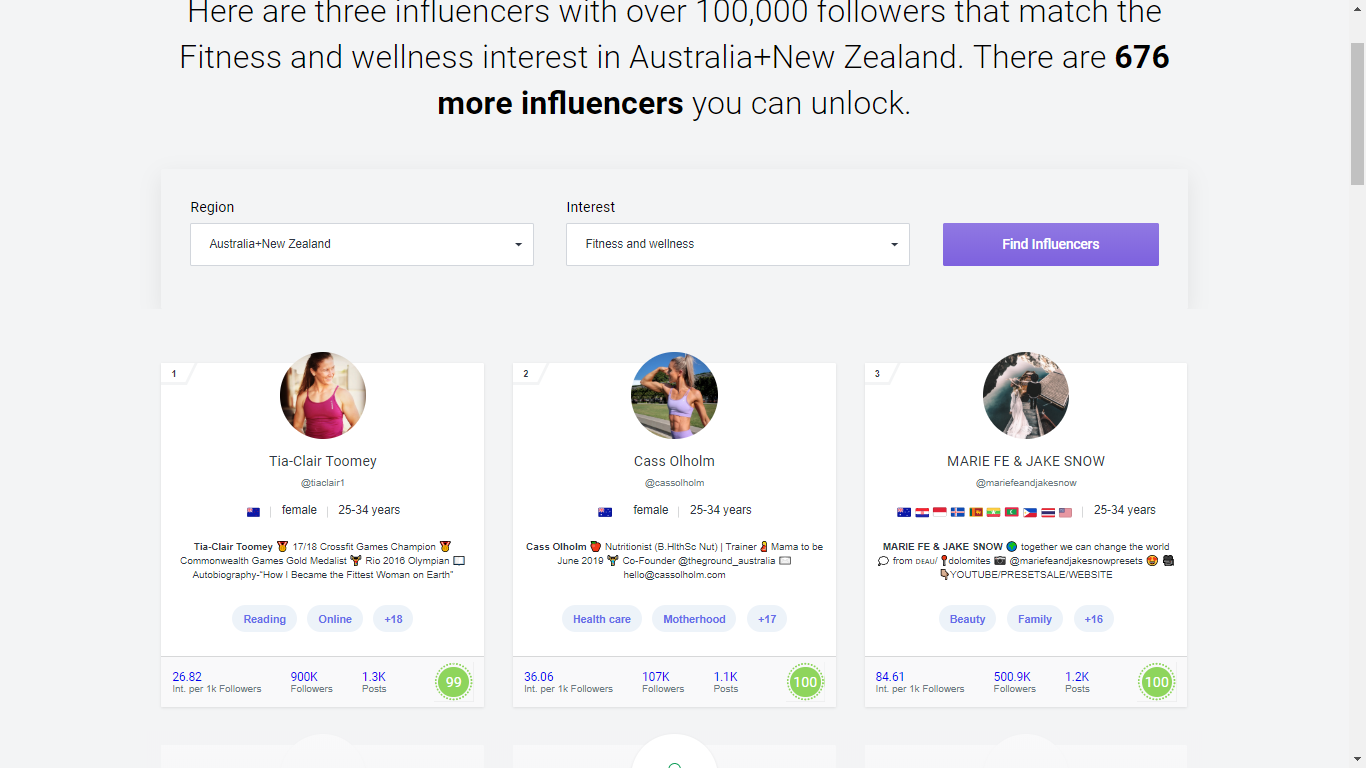
Source: Screenshot
As you can see, it’s possible to search for influencers in specific countries (and even areas, depends on the tool you’re using), so finding a decent option quickly shouldn’t be a problem. What’s a little bit more difficult, however, is determining whether an influencer is perfect for your business. For that, you’ll need to analyze their profiles and learn the following:
- Main topics that the influencer posts about. Is the influencer operating in your market niche?
- The size of the followership. It’s easy to get enticed with a large number of followers, but although having a lot of them is good, it doesn’t mean that all of them are active (that’s why micro-influencers – social media users who have between 1,000 to 1,000,000 followers/audience members – have become so popular in recent years)
- Authentic engagement with their posts (how many comments, likes, etc. does a typical post receive)
- Characteristics of the audience (location, interests, etc.). “If your audience is not international like ours at Top Writers Review, then you should find out where it’s located and whether you can sell to them,” says Scott Jensen, a marketer.
- Their username (should be appropriate and consistent with the image of your brand).
- Replies to follower comments (comments are good, but take a closer look and assess the depth of discussion; if you discover a lot of meaningful replies that stimulate conversation, this is a good sign that the influencer knows how to spark an online discussion)
- The quality of content. Check out the content they’re producing to see if your brand could be represented in such way appropriately
- Previous conflicts and issues. Check if the influencer you’re interested in collaborating with has past issues with the online community, other influencers, or companies. Those who have been involved in scandals or conflicts typically have a damaged reputation, therefore, should not be your choice for a partnership. Since piggybacking on an influencer’s social standing is one of the main points here, having your brand endorsed by someone who doesn’t enjoy a good reputation wouldn’t produce the results you’re hoping to get.
As soon as you identified the influencer you think can be a good fit for your brand, it’s time to talk about business. The first contact with an influencer is something that you should be prepared for, so here’s what you need to know.
How to Contact an Influencer
If you want to use an influencer in your affiliate marketing strategy, you’ve got to have a killer pitch. The most popular way to contact influencers is by an email or a direct message on social media, so choose your preferred method of communication. Your main goal at this point is to write a great message with the information about your goals, products, and your vision of success.
Write your message in simple, conversational language, and be as straightforward as possible in your message so you don’t come off as pushy. Keep in mind that you’re making them a business proposal (by the way, not treating an affiliate like a business partner is one of the most common mistakes that people do when starting an affiliate program), and no influencer wants to be a puppet of any brand; in fact, influencers know that they will lose followers if their messages are perceived as fake.
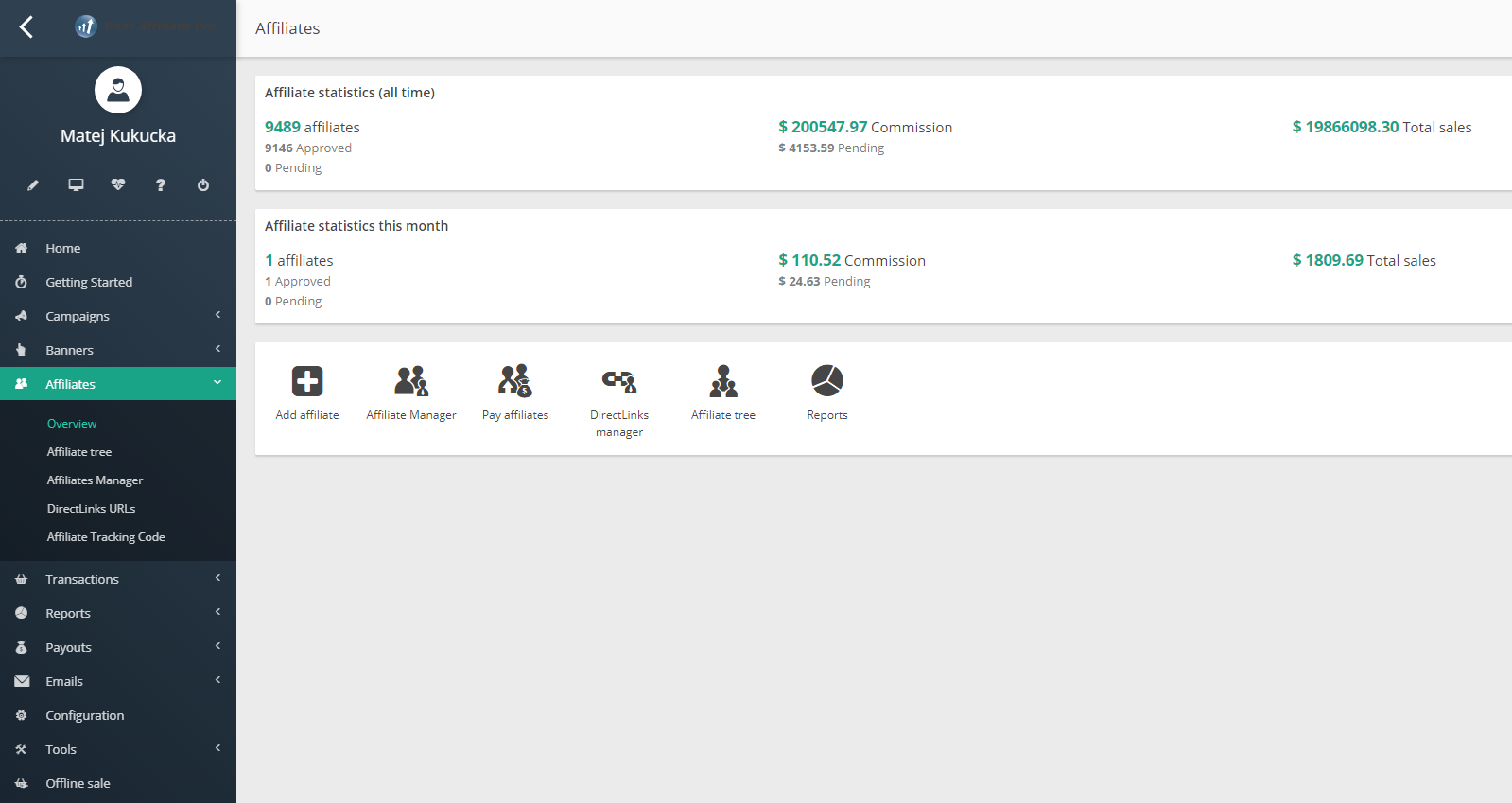
There are several ways in which you can approach writing a message to influencers. Below, we’re going to give you a good example of an email asking an influencer to be an affiliate partner:
Hi [name of the influencer],
My name is [your name], a Baltimore-based coffee brand. We’ve been reading your blog for quite a while and we’re really loving your writing style and tips.
I’m writing this message because we think that you would be an amazing ambassador for our brand.
Are looking for business opportunities at the moment? We would love if you could come on board as an affiliate partner.
If you are, we are ready to share our products with you, so you could try them and give your thoughts about them to your online community in a post.
As a thank you, we will also provide you with an affiliate code so you can earn some commission from your influence.
Please let us know what you think about this: if you’re interested, we are ready for a chat. Feel free to reply to reach out to us by replying to this message.
Thank you! We’re looking forward to hearing from you.
Kind regards,
[Your name].
As you can see, this message begins with the sender complimenting the influencer, which is a good start that can grab their attention. Then, the sender describes the value of the program as well as what they expect from the influencer. Writing in this style ensures that the message reads like a personalized invitation to be an affiliate partner. Besides, the message read genuine because it tries to show that the brand has selected this particular influencer based on their experience.
What’s Next?
Reaching out to an influencer with a request for an affiliate partnership is something you should consider doing to reach more people in a very special way. Influencer marketing has been developing at the speed of light in recent years, and it doesn’t show any kinds of stopping. I recommend you not to listen to those saying that influencers are boring because everyone tries to be one because it’s a legit strategy with thousands of businesses around the world investing millions into it.
Hopefully, this guide has inspired you to know more about influencer marketing and how to use it along with affiliate marketing. Feel free to share your experiences with affiliate partnerships with influencers with us to let us know what tips have worked for you the best!
Share this article
Discover Post Affiliate Pro's flexible pricing plans tailored to fit your business needs, with options for Pro, Ultimate, and Network packages. Enjoy a free trial with no credit card required, no setup fees, and the freedom to cancel anytime. Benefit from features like unlimited affiliates, advanced reporting, customizable interfaces, and lifetime support. Save up to 20% with annual billing and take advantage of more than 220 integrations. Perfect for businesses seeking to enhance their affiliate marketing efforts. Visit now to find the ideal plan for you!
How To Find Affiliates to Sell Your Products
Discover over 10 successful strategies for finding high-quality affiliates in 2024 to boost your product sales. Learn to leverage influencers, join affiliate networks, and enhance your reach through SEO and social media. Maximize revenue with transparency and ongoing monitoring in your affiliate marketing program.
Explore seamless integrations with Post Affiliate Pro to enhance your affiliate marketing strategies. Discover solutions for e-commerce, email marketing, payments, and more, with easy integrations for platforms like 1&1 E-Shop, 2Checkout, Abicart, and many others. Optimize your affiliate network with these powerful tools.
The Evolution of Affiliate Marketing: What to Expect in 2025
Explore the future of affiliate marketing in 2025 with insights and trends to boost your strategy. Discover what's next!
Explore Post Affiliate Pro's comprehensive Affiliate Marketing Glossary to enhance your industry knowledge with easy-to-understand definitions of essential terms. Perfect for marketers seeking to understand the fundamentals and advanced concepts, this glossary helps you master the language of affiliate marketing. Visit now to boost your expertise!













